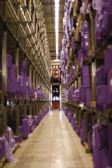To measure your supply chain’s performance, take a look at these three variables.
 Two years ago I had the pleasure of participating in Gartner’s Supply Chain Executive Conference in London.
Two years ago I had the pleasure of participating in Gartner’s Supply Chain Executive Conference in London.
I joined a couple of presentations about supply chain segmentation that I found really interesting. I went home and wrote a couple of blog posts about the topic. The first one talks about supply chain segmentation as a concept.
Last month I attended this year’s conference. I was quite excited to see how much awareness of the strategic importance of supply chain management has increased: in an annual study conducted by Gartner 27 percent of the respondents indicated that supply chain management was strategically important five years ago. That number has steadily grown into this year’s result: 55 percent say that today.
Another interesting fact is that respondents indicated that supply chain segmentation is a major driver for growth.
It appears to me that supply chain management has gone from being confused with logistics with a primary focus on cost and efficiency into being seen as a strategic tool to help companies achieve their growth targets and create sustainable competitive advantage.
In this post, I would like to elaborate a bit more on supply chain segmentation that I firmly believe possesses a great opportunity for improvement among most companies.
Let’s look at three variables that you can use to measure your supply chain’s performance:
- Cost – related to costs for capital tied-up in inventories, obsolesces, transportation, buildings, labor, machines, etc.
- Service – refers to the ability to deliver the product the customer asks for.
- Speed – how fast the customer can get the product once ordered; or in more generic terms, how fast the supply chain can respond once demand is visible.
It is easy to design a cost-efficient supply chain if we stick to a small product range (low service) and accept that sometimes there is a shortage (which will decrease speed).
On the other hand, you can design a supply chain that is fast and offers a wide range of variants if cost isn’t a problem.
![[triangle 1] [triangle 1]](http://blog.ifs.com/wp-content/uploads/2014/10/supplychainseg-triangle1.jpg) We can illustrate these two examples with this triangle:
We can illustrate these two examples with this triangle:
The yellow star represents a highly cost-effective supply chain; and the green star, a fast supply chain that offers lots of products but at a higher cost.
Here’s another example:
The yellow star is McDonald’s. At a reasonably low price you can get a quick meal which sometimes is exactly what you look for. But don’t expect them to accommodate any special wishes.
![[triangle 2] [triangle 2]](http://blog.ifs.com/wp-content/uploads/2014/10/supplychainseg-triangle2.jpg) The green star is the á la carte restaurant. When you have plenty of time and nice company, this is exactly what you look for. Great flexibility and many options to choose from, but you will have to wait for your meal and you expect pay a premium price.
The green star is the á la carte restaurant. When you have plenty of time and nice company, this is exactly what you look for. Great flexibility and many options to choose from, but you will have to wait for your meal and you expect pay a premium price.
In this sense, industrial products are much like restaurants.
Which supply chain characteristics that are the best fit for a particular product can often be derived from the value, the demand profile or the market the product competes in.
Let me clarify this with a couple of examples.
- Spare parts – you can’t get the particular spare part anywhere else, and the huge cost attached to having your equipment out of operation for a significant amount of time means that customers are prepared to pay a premium price for service and speed. Pharmaceutical products also often fall into this category where a shortage in supply can cause serious harm.
- Commodities – are by no means critical: if you can’t deliver, the competitor next door will. To win business in this market, it is important to balance cost and speed.
The problem is that many companies still design “one size fits all” supply chains, and usually with low cost at acceptable customer service as the sole target. The promise of supply chain segmentation is to combine different concepts such as make-to-order, configure-to-order and forecast driven make-to-stock with a range of possible service levels and associated costs into a portfolio of supply chains, or unique demand responses.
Let’s say a company has defined three different demand responses with their attached performance indicators as in this table:
![[table] [table]](http://blog.ifs.com/wp-content/uploads/2014/10/table-supplychaintype.jpg)
The interesting conclusion here is that the results will differ to great extent between these supply chain types. Still they reside within the same physical channel.
In the low cost supply chain type for commodities, maybe a Perfect Order of 90 percent is a great achievement since anything above that would tie up too much inventory which in turn drives cost.
On the other hand, for the high availability supply chain anything below 97 percent would be unacceptable for customers who are happy to pay a premium to be sure the product is available when they need it.
What matters here is to align the supply chain type used for a particular offering with the nature of demand, the competitive landscape and the unique competitive advantages of the products offered. Successfully implemented, this will make a difference no matter if the primary target is to grow top-line, bottom-line or even both.
For more about different techniques to implement supply chain segmentation and how IFS business software can help you, please have a look at two of my previous posts:
- Supply Chain Segmentation And Differentiated Inventory Planning
- Mixed Mode Manufacturing – What’s In It For You?
Do you have questions or comments?
We’d love to hear them so please leave us a message below.